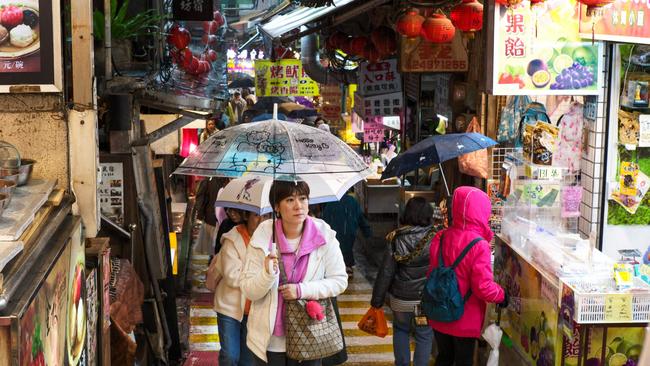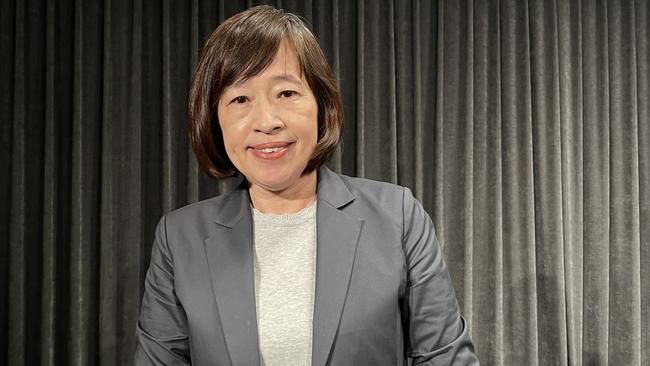Why Australian links and green hydrogen are critical for energy-hungry Taiwan
Taiwan views the development of so-called ‘green’ hydrogen as an important factor in its critical energy relationship with Canberra.

As it braces itself for increasing pressure from China, with increasing uncertainty about the implications of a Trump victory in the US, Taiwan is looking to Australia as a reliable supplier of energy.
Billionaire Andrew Forrest’s retreat from green hydrogen has punched a hole in the much-hyped energy source.
But in meetings with government officials in Taipei this week, it was clear that the self-ruled island sees green hydrogen as an important new factor in its critical energy relationship with Canberra.
Australia has been Taiwan’s largest provider of energy and resources for more than four decades with exports of coal and LNG. Now, as the island’s energy demand is under pressure given the success of its chip industry, and its government goes ahead with the closure of its remaining nuclear power plants – with one reactor set to close on Saturday – it is under heavy pressure to look for new sources of green energy.
While the economics of green hydrogen are a long way from stacking up, with one of the biggest proponents in Australia, the Dr Forrest-founded Fortescue, this month cutting back on its plans for green hydrogen, Taiwanese officials have made it clear they want to be part of any long-term development of the sector – alongside other regional energy importers such as Japan and South Korea.

“Energy potential will play an important role in Taiwan’s development in the next 10 years,” the Deputy Minister of Taiwan’s National Development Council, Kao Shien-Quey, told The Weekend Australian.
“We all know that Australia has been a pioneer in the deployment of different green energy technologies including solar, hydrogen or even the more forward-looking green hydrogen,” Ms Kao added.
“For Taiwan, as we focus on the energy transition, we hope to collaborate with Australia further in terms of the importing of green hydrogen or investment in green hydrogen technology or even green ammonia.
“In Taiwan we currently do not have sufficient green energy to support the domestic production of green hydrogen. Green hydrogen will present a promising opportunity for bilateral co-operation.”
Taiwan’s Deputy Foreign Minister, Tien Chung-kwang, who has fond memories of his time working in Brisbane many years ago, echoed Ms Kao’s views in a meeting the following day as he sipped on a 2015 shiraz from Tyrone Estate in South Australia at an official banquet for visiting foreign journalists.
“We are probably one of the largest importers of natural resources from Australia including iron ore, coal and LNG,” he said. “We understand Australia is developing hydrogen, which is a very important energy for the future.”
Taiwan sees Australia’s exports of green ammonia as a model for it to follow. “You are already exporting it to Japan,” Mr Tien said.
He pointed to Atlassian chief Mike Cannon-Brookes’s planned SunCable link to supply solar power from Australia to Singapore as an example of Australia looking to have green energy links with Asia, describing it as “remarkable”.
“We would like to work with Australia on natural resources,” he said. “You have an abundance of natural resources.
“We would like to work with Australia to develop the new technology around hydrogen as well as some other future energy that we can develop.”
Taiwan sees Australia as a supplier of green energy, with its energy demand made more urgent with the decision to shut down its nuclear power plants by next year.
The country is in the same earthquake zone as Japan, whose energy policies were reshaped following the Fukushima nuclear disaster of 2011, making the country more reliant on imports of fossil fuels such as oil, gas and coal.
Taiwan’s nuclear power plants, which have been in operation for decades, delivering a low-cost source of energy, are now closing.
The first reactor of the Ma-anshan Nuclear Power Plant in Pingtung County in the south of the island is due to close on Saturday.

The Taipei Times this week said if power generation was to keep up with the country’s economic growth, Taiwan would need to consider building a fourth or fifth LNG import terminal.
It quoted the Minister of Economic Affairs, JW Kuo, as saying that the government’s progress in implementing its plans to move to more green energy had “taken a minor setback,” encouraging citizens to be more vigilant in saving energy.
Taiwan received another reminder of the importance of meeting its net zero by 2050 target when the country was hit by a typhoon, an event that some argue has become more frequent due to climate change.
Australia and Taiwan have been having discussions on the potential for co-operation on green hydrogen since 2021, when there was a high-level dialogue between the Australian office in Taiwan with Taiwan’s Ministry of Economic Affairs.
This week’s comments by Taiwanese officials follow a meeting between the Australian Office in Taipei and the Taipei Economic and Cultural Office in May, when both sides renewed an arrangement on science and technology co-operation.
The arrangement updates a previous memorandum of understanding between Australia and Taiwan that includes focus on co-operation in areas of critical technology supply chain resilience and the transition to net zero.
Taiwanese officials this week said they expected more discussions with Australian officials on the issue later this year.
Those officials have been watching as shipments of green ammonia have been made from Australia to Japan, and want to become part of the action.
“Your ships go right past us,” said Ministry of Economic Affairs official G.J. Lee, who has a keen interest in Australia, having spent three years working in Canberra.
“Hopefully they can also stop by here.”
The officials see collaboration on green hydrogen as the logical next step in a long history of energy ties with Australia. One of the first deals has been struck by Taiwanese company Green Harvest, which signed a green hydrogen development agreement with Australia in May. Under the agreement, the first shipments of green ammonia are expected to go to Taiwan in 2028 from a plant in Gladstone in Queensland.
Green Harvest said the first phase of the project was expected to be completed by 2028, with an annual production capacity of 1 million tonnes.
Commenting on the deal, the company’s chairman, Chen Kun-hong, said Australia had a significant advantage over Taiwan in its energy costs.
The company said Australia had the lowest cost of solar power in the world, with green electricity costing less than one Taiwan dollar per kilowatt hour – a fifth of Taiwan’s feed-in tariff (FIT).
“Typically, electrolysing one kilogram of water consumes 55kWh of electricity,” it noted.
“In Taiwan, it costs $T275 ($12.80) to produce hydrogen from 1kg of water, while in Australia it costs only $T55. This is unimaginable for Taiwanese companies under the FIT system,” Mr Chen said, declaring that the deal would help pave the way for Taiwan’s energy transition.
Reporting on the deal, Taiwanese journalist Hsu Tsu-lin said Green Valley had struggled to broker Taiwan’s first green hydrogen development agreement with Australia, as many projects had already been claimed by Japan, South Korea, the US and Germany.
Mr Chen said Taiwan could reach as much as 80 per cent of its renewable energy plans with solar and wind, but needed energy storage through the use of green hydrogen or ammonia to get to 100 per cent.
Australia is already one of the most important suppliers of energy to Taiwan – supplying two-thirds of Taiwan’s coal, and almost half of its natural gas.
Taiwan’s demand for energy is increasing because of the explosive growth of its semiconductor sector. Taiwan makes 60 per cent of the world’s semiconductors, including 90 per cent of the most advanced chips produced by companies including semiconductor giant TSMC.
Some analysts have described the growing influence of the semiconductor industry as a “Silicon Shield” – providing outside forces with a powerful incentive to protect the island in case of threats from China.
While that has yet to be tested, the rise of its chip industry has come at the cost of increasing demand for energy at a time when the world has committed to becoming net zero by 2050.
TSMC may be an economic powerhouse for the island but it does it at a price of using 6 per cent of its total energy consumption.
Taiwan’s industrial sector is responsible for 56 per cent of its total energy use. Residential consumption accounts for only 18 per cent.
The country last year used 276 terawatt hours of power, or 11,807 kilowatt hours (kWh) per capita, much higher than other developed countries other than the US.
The official plan is for offshore wind to be a key factor in its renewable energy future with plans for it to increase from its current levels of 5.6GW to 40-50GW by 2050.
Australian investors have been involved in its renewable energy plans. Macquarie was one of the early investors in Taiwan’s first wind farm, the giant Formosa in Taiwan Straits with 20 turbines.
Last year it completed the installation of another 47 turbines in the Formosa 2 wind farm.
With Australia having supplied Taiwan with the energy of the past, Taiwan is looking to Australia to help it develop the renewable energy of the future.
Glenda Korporaal travelled to Taiwan as a guest of the Taiwanese government.




To join the conversation, please log in. Don't have an account? Register
Join the conversation, you are commenting as Logout